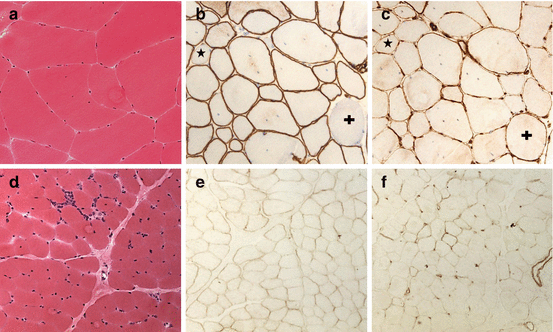Fig. 31.1
Quadriceps needle biopsy from a 3 year old boy with Duchenne muscular dystrophy carrying a hemizygous nonsense mutation in exon 32 of the dystrophin gene predicted to cause a severe phenotype. Haematoxylin and Eosin stained sections (a, b) show moderately severe dystrophic changes including increased fibre size variation and internal nuclei, perimysial and endomysial fibrosis, necrotic fibres and clusters of basophilic regenerating fibres. Immunostaining with the Leica/Novocastra Dys1 antibody (rod domain) shows almost complete absence of dystrophin except strong labeling of a few ‘revertant’ fibres (c); the latter thought to arise by restoration of the reading frame due to exon skipping. In contrast utrophin that is normally restricted to blood vessels and nerves is diffusely over-expressed at the sarcolemma of myofibres (d). Other secondary changes in the dystrophin-associated protein complex include virtual absence of sarcolemmal NNOS (e) and patchy depletion of gamma-sarcoglycan (f)

Fig. 31.2




Quadriceps biopsy from a 28 year old female manifesting carrier of Duchenne muscular dystrophy carrying a deletion of exons 45–50 predicted out-of-frame in the dystrophin gene (a–c). Haematoxylin and Eosin stained section (a) shows mild dystrophic features including abnormal fibre size variation and focal necrosis/regeneration (not shown). Dystrophin immunostaining shows randomly scattered fibres (b; star and cross) lacking sarcolemmal dystrophin resulting in a ‘moasic pattern’ of dystrophin loss due to random X chromosome inactivation. Utrophin is upregulated on fibres with and without dystrophin (c). Quadriceps needle biopsy from a 6 year old boy with Becker muscular dystrophy carrying a mutation in the donor splice site of exon 41 of the dystrophin gene predicted to cause an in-frame deletion and a milder phenotype. Haematoxylin and Eosin stained section shows mild dystrophic changes (d). Dystrophin labeling shows an overall reduction at the sarcolemma of most fibres (e). Utrophin upregulation is mild-to-moderate, patchy and stronger in some fibres, probably regenerating (f)
Stay updated, free articles. Join our Telegram channel

Full access? Get Clinical Tree






